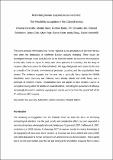Files in this item
Rethinking human responses to sea-level rise : the Mesolithic occupation of the Channel Islands
Item metadata
| dc.contributor.author | Conneller, Chantal | |
| dc.contributor.author | Bates, Martin | |
| dc.contributor.author | Bates, Richard | |
| dc.contributor.author | Schadla-Hall, Tim | |
| dc.contributor.author | Blinkhorn, Edward | |
| dc.contributor.author | Cole, James | |
| dc.contributor.author | Pope, Matt | |
| dc.contributor.author | Scott, Beccy | |
| dc.contributor.author | Shaw, Andy | |
| dc.contributor.author | Underhill, David | |
| dc.date.accessioned | 2016-04-01T14:00:06Z | |
| dc.date.available | 2016-04-01T14:00:06Z | |
| dc.date.issued | 2016-12 | |
| dc.identifier | 241561019 | |
| dc.identifier | 9eabdc6f-c438-4877-9ea9-7b0ffef9cd6c | |
| dc.identifier | 84998812272 | |
| dc.identifier.citation | Conneller , C , Bates , M , Bates , R , Schadla-Hall , T , Blinkhorn , E , Cole , J , Pope , M , Scott , B , Shaw , A & Underhill , D 2016 , ' Rethinking human responses to sea-level rise : the Mesolithic occupation of the Channel Islands ' , Proceedings of the Prehistoric Society , vol. 82 , pp. 27-71 . https://doi.org/10.1017/ppr.2016.1 | en |
| dc.identifier.issn | 0079-497X | |
| dc.identifier.other | ORCID: /0000-0001-9147-7151/work/29591574 | |
| dc.identifier.uri | https://hdl.handle.net/10023/8540 | |
| dc.description.abstract | This work provides new insights into human responses to and perceptions of sea-level rise at a time when the landscapes of north-west Europe were radically changing. These issues are investigated through a case study focused on the Channel Islands. We report on the excavation of two sites, Canal du Squez in Jersey and Lihou (GU582) in Guernsey, and the study of museum collections across the Channel Islands. We argue that people were drawn to this area as a result of the dynamic environmental processes occurring and the opportunities these created. The evidence suggests that the area was a particular focus during the Middle Mesolithic, when Guernsey and Alderney were already islands and while Jersey was a peninsula of northern France. Insularisation does not appear to have created a barrier to occupation during either the Middle or Final Mesolithic, indicating the appearance of lifeways increasingly focused on maritime voyaging and marine resources from the second half of the 9th millennium BC onwards. | |
| dc.format.extent | 45 | |
| dc.format.extent | 560595 | |
| dc.language.iso | eng | |
| dc.relation.ispartof | Proceedings of the Prehistoric Society | en |
| dc.subject | Sea-level rise | en |
| dc.subject | Mesolithic | en |
| dc.subject | Marine resources | en |
| dc.subject | Channel Islands | en |
| dc.subject | Maritime voyaging | en |
| dc.subject | GE Environmental Sciences | en |
| dc.subject | NDAS | en |
| dc.subject | SDG 14 - Life Below Water | en |
| dc.subject.lcc | GE | en |
| dc.title | Rethinking human responses to sea-level rise : the Mesolithic occupation of the Channel Islands | en |
| dc.type | Journal article | en |
| dc.contributor.institution | University of St Andrews. Earth and Environmental Sciences | en |
| dc.contributor.institution | University of St Andrews. Centre for Ancient Environmental Studies | en |
| dc.contributor.institution | University of St Andrews. Marine Alliance for Science & Technology Scotland | en |
| dc.contributor.institution | University of St Andrews. Scottish Oceans Institute | en |
| dc.contributor.institution | University of St Andrews. St Andrews Sustainability Institute | en |
| dc.identifier.doi | https://doi.org/10.1017/ppr.2016.1 | |
| dc.description.status | Peer reviewed | en |
This item appears in the following Collection(s)
Items in the St Andrews Research Repository are protected by copyright, with all rights reserved, unless otherwise indicated.

